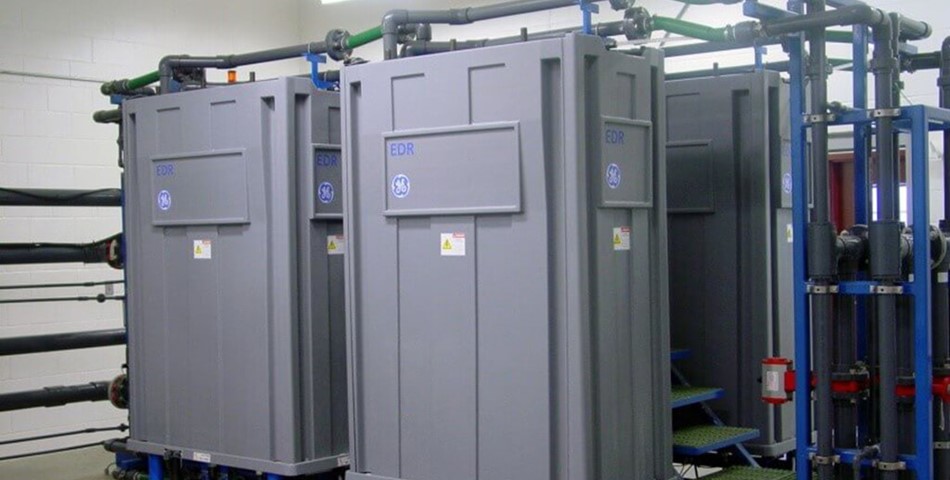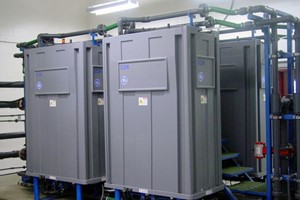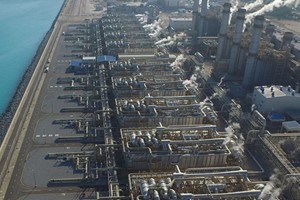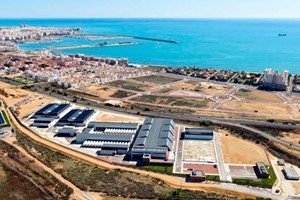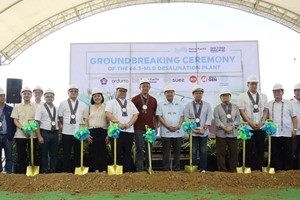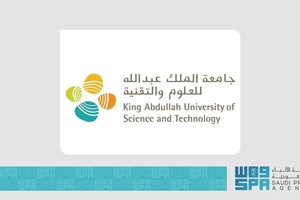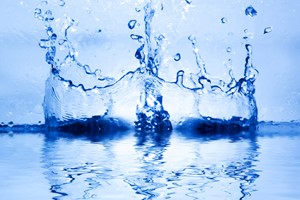High-Recovery Brackish Water Desalination.
Electrodialysis reversal desalination, commonly abbreviated EDR, is a water desalination process in which electricity is applied to electrodes to pull naturally occurring dissolved salts through an ion exchange membrane to separate the water from the salts. EDR produces two effluent streams: a low salinity product water and a high salinity concentrate.
In the reversal process, the polarity of the electrodes is switched at fixed intervals to reduce the formation of scale and subsequent fouling and allow the EDR to achieve higher water recoveries.
EDR is used to treat brackish waters with moderate total dissolved solids (TDS) and waters that have a high scaling potential due to elevated levels of contaminants such as barium (Ba) and strontium (Sr). EDR is also effective on high silica (SiO2) feedwaters.
Electrodialysis (ED) has been employed by several industries as a treatment strategy of saline waters and brines (i.e., ED metathesis). However, in recent years its interest years for the treatment of metal-contaminated water has arisen. The working principle of ED (is based on the migration of anions and cations across anion exchange (AEM) and cation exchange membranes (CEM), respectively, due to the application of an electric field. The CEM is negatively charged to attract metallic cations while the AEM is positively charged to attract anions. The electric field acts as a driving force for the migration of the species and can promote or reduce the migration, removal, and recovery. A complete work with a detailed ED background description was published elsewhere.
EDR Principles
Gradiant’s Electrodialysis Reversal (EDR) systems use an electric current to migrate dissolved salt ions through a membrane stack. The units contain alternating layers of cationic and anionic ion exchange membranes. The direction of ion flow is periodically reversed by changing the polarity of the applied electric current. Different ion exchange membrane configurations and types may be used to selectively concentrate or extract specific target ions, allowing the product water salinity to be tuned to a target TDS concentration.
Process Advantages
EDR can provide compelling cost advantages in some situations. Unlike RO, which relies on pressurized water, EDR uses voltage differences to drive ions. This results in greater tolerance to inorganic scaling and biological fouling and reduces pre-treatment and chemical needs. The decision to use EDR, RO, or other technologies depends on case-specific conditions, such as feed and product water TDS and if selective ion removal is required. Typical applications in brine concentration, brackish water desalination of groundwater, and ultrapure water production.
Key Benefits of Gradiant's EDR Technology:
Robust System Reliability
Treatment of water with high inorganic scale (such as silica) or biological contamination. Higher turbidity allowance.
Selective Ion Removal
Selective concentration and extraction of ions based on ion exchange membrane configurations.
Lower CAPEX and OPEX
Cost advantages in case-specific conditions depending on water chemistry and process needs. Reduced pre-treatment and chemical needs, and brine disposal costs.
Advantages and Disadvantages of ED (and EDR) System
Advantages:
- ED system separates without phase change, which results in relatively low energy consumption.
- When brackish water is desalted by ED system, the product water needs only limited pre-treatment. Typically, only chlorination for disinfection is required.
- Because ED system removes only ionized species, it is particularly suitable for separating non-ionized from ionized components.
- Osmotic pressure is not a factor in ED system, so the pressure can be used for concentrating salt solutions to 20% or higher.
Disadvantages:
- Organic matter, colloids and SiO2 are not removed by ED system.
- Feedwater pre-treatment is necessary to prevent ED stacks fouling.
- Elaborate controls are required and keeping them at optimum condition ca be difficult.
- Selection of materials of construction for membranes and stack is important to ensure compatibility with the feed stream.
Desalination System Market
Desalination systems are used to extract the salt or removal of salt from the sea water and produce water that is more suitable to human consumption, irrigation, and various industrial uses.
The availability of fresh water for consumption is very low and is declining at a faster rate. With the rise in demand for fresh water, there is a need for an alternative source of fresh water. This problem can be solved by using desalination system, which turns the unusable sea water into fresh water, by removing the salt and various minerals from the sea water. Desalination system works by using either electrical, thermal, or chemical energy.
The global Desalination System market is valued at 12240 million US$ in 2020 is expected to reach 17470 million US$ by the end of 2026, growing at a CAGR of 5.2% during 2021-2026.
Rapid industrialization, coupled with the growing requirement for effective and efficient wastewater management systems worldwide, is primarily driving the market growth. Furthermore, the depleting levels of freshwater reserves are also propelling the demand for water desalination equipment. In line with this, the governments of various nations are increasingly investing in the development of water desalination plants to maintain the supply of drinkable water. Additionally, numerous technological advancements, such as the introduction of hybrid desalination process equipment and multi-stage (MSF) distillation technology, are acting as another growth-inducing factor. Besides this, the increasing adoption of compact water purification and desalination equipment by the residential and commercial sectors is projected to further drive the market growth in the coming years.



